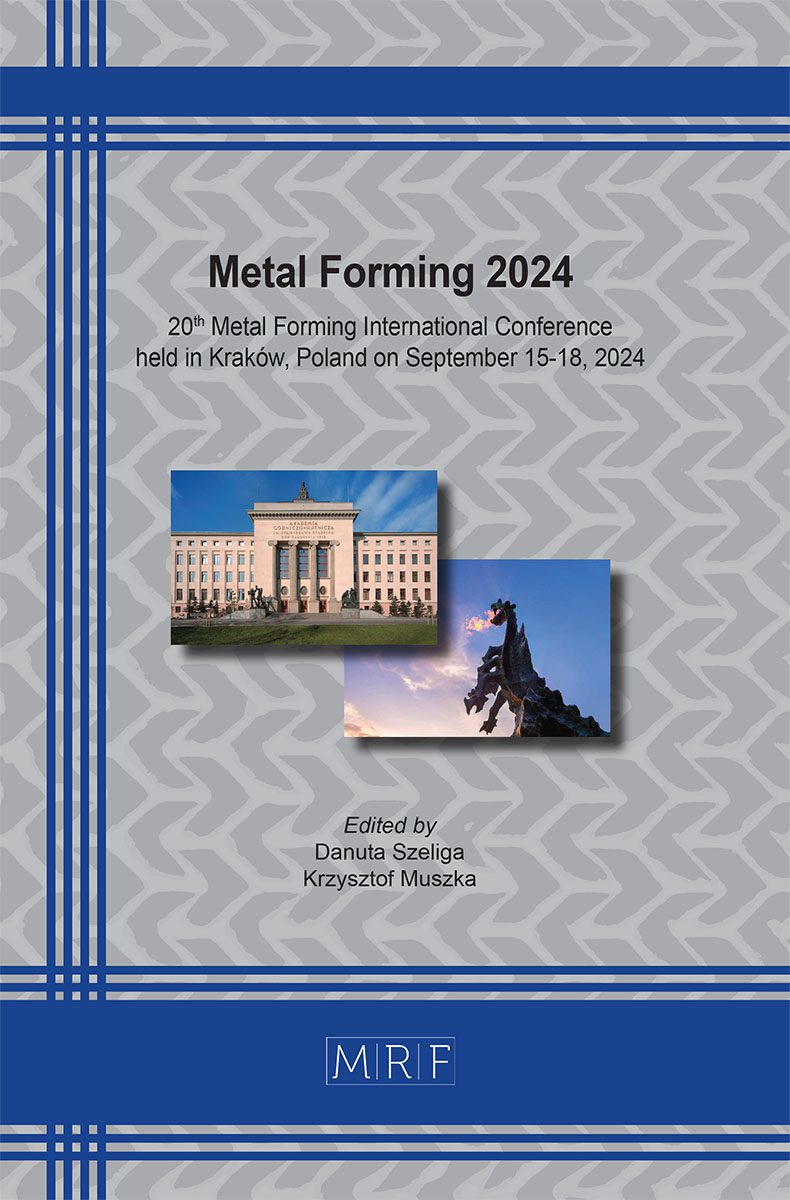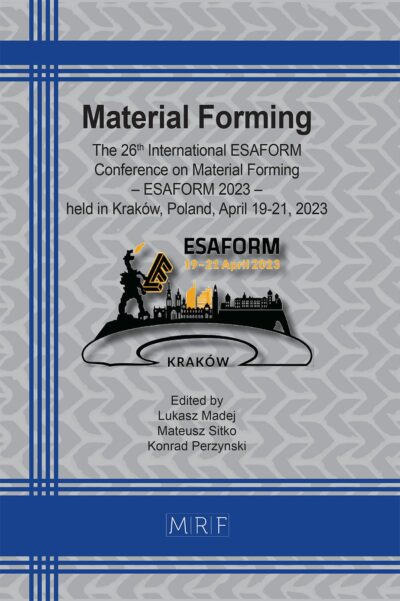–
Design and simulation of cross wedge rolling process for hollow motor shaft
HAN M., LIU J.X., SHI M.J., SONG H.W., ZHANG S.H., CHENG M.
download PDFAbstract. Nowadays, electric cars are experiencing rapid development, in which the production of motor shaft is one of the important parts. The cross wedge rolling (CWR) process is expected to be an efficient and material-saving production method for motor shaft production. Traditional motor shafts are manufactured by forging and machining, which inevitably causes material waste. While using the CWR method to produce the motor shaft, the forming accuracy can be improved, keeping the material performance. It’s possible to manufacture the hollow motor shaft billet directly and reducing the production cost greatly. Because of the asymmetric geometry profile of the motor shaft, the force is unbalanced during the forming process. The thermo-mechanical coupling finite element simulation is used to design and optimize the flat CWR tools. Then, the distribution of stress, strain, damage and temperature during the CWR process are analyzed. The traditional CWR process will easily cause central defects of the shaft such as micropores and voids. The hollow billet is used in the study. It helps to avoid such defects, also can be a new method to deal with the hollow motor shafts by CWR. Some disadvantages of traditional manufacture can be overcome.
Keywords
Hollow Motor Shaft, Cross Wedge Rolling, Hollow Billet, Numerical Simulation
Published online 9/15/2024, 10 pages
Copyright © 2024 by the author(s)
Published under license by Materials Research Forum LLC., Millersville PA, USA
Citation: HAN M., LIU J.X., SHI M.J., SONG H.W., ZHANG S.H., CHENG M., Design and simulation of cross wedge rolling process for hollow motor shaft, Materials Research Proceedings, Vol. 44, pp 124-133, 2024
DOI: https://doi.org/10.21741/9781644903254-14
The article was published as article 14 of the book Metal Forming 2024
![]() Content from this work may be used under the terms of the Creative Commons Attribution 3.0 license. Any further distribution of this work must maintain attribution to the author(s) and the title of the work, journal citation and DOI.
Content from this work may be used under the terms of the Creative Commons Attribution 3.0 license. Any further distribution of this work must maintain attribution to the author(s) and the title of the work, journal citation and DOI.
References
[1] Z. Pater, J. Tomczak, T. Bulzak, J. Bartnicki, A. Tofil, Prediction of Crack Formation for Cross Wedge Rolling of Harrow Tooth Preform, Materials 12 (2019) 2287-2287. https://doi.org/10.3390/ma12142287
[2] P.A. Li, B.Y. Wang, C. Yang, H. Zhang, W. Li, J. Zhou, Study on necking defects, microstructure and mechanical properties of TC4 alloy by cross wedge rolling, Int. J. Mater. Forming 15 (2022). https://doi.org/10.1007/s12289-022-01718-z
[3] Z.M. Yu, W.F. Peng, X. Zhang, M. Oleksandr, V. Titov, Evolution of microstructure of aluminum alloy hollow shaft in cross wedge rolling without mandrel, J. Central South University 29 (2022) 807-820. https://doi.org/10.1007/s11771-022-4950-8
[4] X. Ren, Y.M. Huo, S.R.E. Hosseini, T. He, Z. Yan, F.A.O. Fernandes, A.B. Pereira, H. Ji, J. Bai, Z. Bian, X. Du, A multi-scale modelling by coupling cellular automata with finite element method and its application on cross-wedge rolling, Materials Today Commun. 37 (2023) 106976. https://doi.org/10.1016/j.mtcomm.2023.106976
[5] T. Bulzak, Assessment of the Susceptibility to Material Fracture in the Cross-Wedge Rolling Process with Concave Tools, Materials 15 (2022) 6605-6605. https://doi.org/10.3390/ma15196605
[6] A.Q. Tian, X.H. Xu, L. Sun, Y.L. Deng, Effects of interrupted ageing and asymmetric rolling on microstructures, mechanical properties, and intergranular corrosion behavior of Al-Mg-Si-Zn alloy, J. Central South University 29 (2002) 821-835.
[7] Z. Pater, T. Bulzak, J. Tomczak, Cross-Wedge Rolling of Driving Shaft from Titanium Alloy Ti6Al4V, Key Eng. Mater. 3939 (2016) 687-687. https://doi.org/10.4028/www.scientific.net/KEM.687.125
[8] Z. Pater, J. Tomczak, Experimental Tests for Cross Wedge Rolling of Forgings Made from Non-Ferrous Metal Alloys, Arch. Metall. Mater. 57 (2012) 919-928. https://doi.org/10.2478/v10172-012-0101-9
[9] Z. Pater, J. Tomczak, T. Bulzak, Rotary compression as a new calibration test for prediction of a critical damage value, J. Mater. Res. Tech. 9 (2020) 5487-5498. https://doi.org/10.1016/j.jmrt.2020.03.074
[10] P.A. Li, B.Y. Wang, P.N. Feng, J. Shen, J. Wang, Numerical and experimental study on the hot cross wedge rolling of Ti-6Al-4V vehicle lower arm preform, Int. J. Adv. Manuf. Tech. 118 (2021) 3283-3301. https://doi.org/10.1007/s00170-021-07979-3
[11] L.F. Lin, W.F. Peng, S. Zhu, Z. Wu, J. Zhu, Y. Shao, H. Li, M. Oleksandr, V. Titov, Cross wedge roll bonding process for laminated shafts forming: Interface microstructure, bonding mechanism, and parameter influence, J. Mater. Process. Tech. 317 (2023). https://doi.org/10.1016/j.jmatprotec.2023.117971














